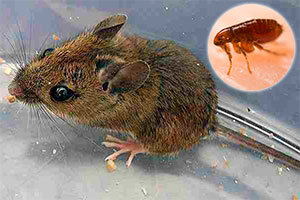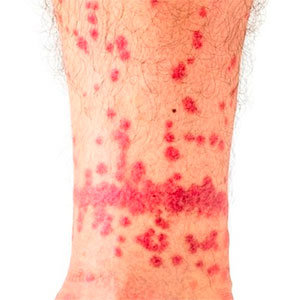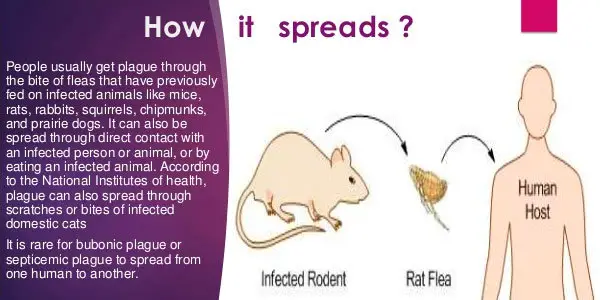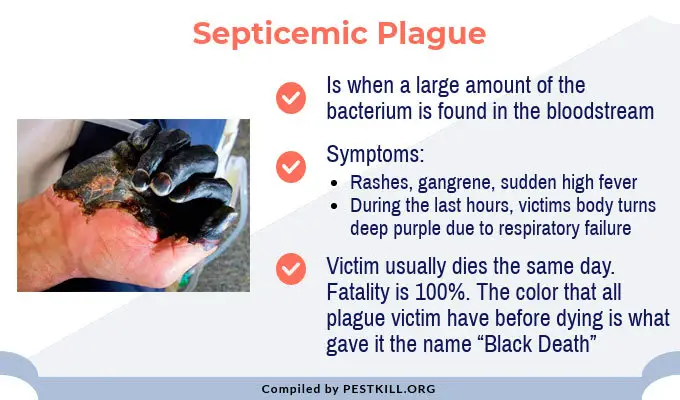
- LAST UPDATED: December 7, 2023
It’s notoriously difficult to get rid of mice once they’ve invaded your home. A female mouse can start reproducing when it’s only six weeks old and can keep giving birth to as many as 14 babies every 21-30 days. But that’s not all; a pair of mice have the reproductive capacity to create 2,000 offspring in a year.
Clearly, mouse populations can expand very quickly. That implies any problem associated with the rodents can be propagated just as fast.
It’s not unusual for people with a mouse problem to find themselves having to deal with a flea infestation. Is there any connection between the two? Do mice carry fleas? Let’s explore this frequently asked question about the two pesky pests.
Contents
Do Mice Have Fleas?
If you own a cat or dog, you’ve probably encountered fleas. They’re just a few millimeters long. They have laterally flattened bodies that range from yellowish to reddish-brown in color.

Fleas need blood to grow and produce eggs. They look for hosts to live off. Adult fleas get the nutrients they require by drawing blood from their host. They prefer feeding on hairy animals.
Although fleas are commonly associated with cats and dogs, you can find them on other hairy domesticated and wild animals. Mice have fur, so they’re not immune to fleas.
Mice have big eyes, cute ears, and fluffy bodies. These can make the rodents appear harmless.
Signs of a mouse with fleas
Wild mice, field mice, and house mice are all capable of getting fleas. While it’s virtually unheard of, pet mice too can get fleas.
There are two telltale signs of a mouse that has fleas:
- When they get fleas, these rodents itch and scratch a lot.
- Their fur and habitat may have signs of blood spots, which indicate fleas are actively biting the mice.
Can Mice Introduce Fleas to Your Home?
Mice can get into your house through holes as small as 1/4 inches due to their flexible bodies. If the holes don’t fit them, they’ll readily gnaw their way into the house. They gnaw a small hole until it’s wide enough for them to gain entry to your home.
These critters have a set of incisors that keep growing, so they have to gnaw on non-food items to grind these teeth down. That may make you wonder, “Do mice bite?” Read this article to find out.
Because of their fur, mice are excellent carriers of fleas. As they squeeze through holes to get into your home, they can bring fleas with them. Once inside, the insects can hop from the mice onto the back of your pet. Their populations can build up to large numbers quickly.
It’s crucial to keep monitoring traps, double-bagging any captured rodents, and safely discarding them in trash bins. Alternatively, you could prevent the fleas from finding new hosts by using live traps.
What about the mice outside your home?
Mice don’t have to get into your home to introduce fleas indoors. They can do that by merely hanging out near your house.
Fleas love wooded areas and tall grasses. Flea-infested mice can bring these parasites into your yard. The insects will gladly jump ship and set up house on your pets as they roam outside. The pets will then carry the fleas into your home.
Flea Issues That Go Hand in Hand with Mouse Problems
When mice enter your home, they’ll want to build a nest as well as look for food and water. In the process, they can cause damage to food, electronics, furnishings, insulation, and other items in your home.
They can chew through electrical cables, causing your alarm systems to go off and leaving your wires needing significant repair. This mouse habit can also cause house fires. The urine and feces of these rodents can contaminate your food and water, potentially spreading diseases.
Flea problems around your home caused by mice
Evidently, dealing with a mouse infestation is no easy task. Combine this with a flea infestation, and you have one huge predicament.
Fleas can be a nuisance in the following ways:
- Flea Bites. Fleas can bite both pets and people. Their bites irritate the skin and usually result in uncomfortable itching or rashes. Pets can develop allergies to the saliva of fleas. Flea bites on people usually appear as numerous red marks that are inflamed and itchy. Some people are more susceptible to flare-ups after they’ve been bitten.
-
Diseases. Mice fleas can cause health problems to both humans and animals.
Let’s take a look at some of them below:
- Tapeworms. That little mouse that has invaded your home may be carrying fleas, which may be carrying tapeworms. These worms take up residence in the intestines of pets and humans.Your pet can contract the worms if they swallow infected adult fleas. Your cat can be infected by consuming infected rodents. Kids can get this disease if they unknowingly swallow an infected flea.
- Plague. The plague can be transmitted to humans by handling the tissue or fluid of an infected mouse. However, the most significant danger is the fleas being carried by the infected rodent. When fleas feed on an infected mouse, their bites can transmit this disease to humans and other animals.
In the 14th century, the disease killed about one-third of Europe’s population. Today, we still have outbreaks of the disease in some areas due to the infected fleas of mice and rats.
Exposure to mice fleas can lead to the development of these forms of plague:
- Bubonic plague. It’s the most common type of plague. Its symptoms include swollen lymph nodes, fever, weakness, chills, and headache.
- Septicemic plague. This form develops if bubonic plague remains untreated. Its signs include extreme weakness, fever, diarrhea, abdominal pain, delirium, shock, and body tissues turning black.
Simultaneous Control of Mice and Fleas
You can take the steps below to keep the dreaded combination away from your home:
- Inspect your home for any cracks, gaps, and holes that can allow mice to move in unnoticed. Seal them with spray foam, caulk, or any other suitable type of patch. These exclusion practices will indirectly keep fleas out by eliminating the entry points of their potential hosts. Make sure you keep any possible food sources in sealed containers.
- Keep your grass mowed and bushes trimmed. Rake and dispose of any vegetative litter. Tallgrass and weeds provide a food source and ideal hideout for mice as well as fleas. Have your yard professionally treated for fleas.
- Ensure your cats and dogs are treated with approved flea prevention treatments regularly. You can’t control the mice population outside your property, so these products help you protect your pets from exposure to fleas when you’re taking them for a walk.
- Vacuum your rugs, carpets, and upholstery frequently. Research has shown that vacuuming can eliminate as much as 95 percent of these bloodsucking parasites’ eggs, larvae, and adults.
Mice can carry fleas, which can cause the deadly plague. You have more than enough reason to take preventive measures to lock these pests from your property. If you see mice around your home, don’t wait for the problem to grow into a catastrophe. Embark on a mice control program as soon as possible.












